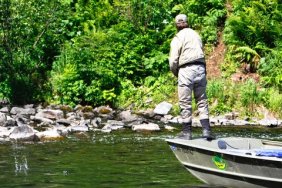 When seeking out trophy largemouth bass, it’s smart to locate the nastiest brush piles, thickest weed beds, gnarliest log jams, and messiest rock piles in the lake. As a general rule, if it looks like a place your lure will never make it out of alive, then it’s worth a few moments of your time. This is where your flipping and pitching prowess will be tested. Today, I’ve highlighted a few tips to give you a refresher course on this technique to help you hone your skills even further.
When seeking out trophy largemouth bass, it’s smart to locate the nastiest brush piles, thickest weed beds, gnarliest log jams, and messiest rock piles in the lake. As a general rule, if it looks like a place your lure will never make it out of alive, then it’s worth a few moments of your time. This is where your flipping and pitching prowess will be tested. Today, I’ve highlighted a few tips to give you a refresher course on this technique to help you hone your skills even further.
Boat positioning is a crucial element of flipping. A strike can occur without warning at any given moment, so make sure your boat is always positioned correctly. This will make fighting the fish amidst weeds and other objects much easier.
Because bass can be so very sneaky when they grab a lure, it’s important to be constantly aware of the depth at which you’re fishing. If you’re fishing in five feet of water and your jig only drops three feet, set the hook. Often times, an aggressive bass will take your lure before it ever has a chance to reach the bottom of the lake. Along those same lines, keep a close eye on your line. If it jumps or moves in any direction, set the hook. It’s also helpful to keep a finger in contact with the line, so you can feel subtle bites and touches.
Rod position is very important when you’re flipping. I don’t let my rod get any higher than 45 degrees. When you believe you have a solid bite, drop your rod towards the water and take up any slack line with a couple quick turns of the reel. Then you’re ready for a good solid hook set.
On certain days, a more subtle presentation works best, while there will also be days when a lure with a rattle or bright trailer will be your best bet. As always, though, the bass will tell you what they want on a given day, so it’s smart to keep a variety of options at your disposal.
When actually flipping and pitching your lures, work them as if you’re trying to snag them. I know this is a scary notion, but it helps you get your lure into every nook and cranny. I would rather lose a few lures than pass up a big fish. This can do some damage to your hooks and line over time, though, so keep an eye out for dull hooks or line frays.
The key to flipping and pitching is seeking out the messiest parts of the lake—weeds, logs, and rocks—where big bass can ambush prey items and doing your best to pick those areas apart like a Thanksgiving turkey. Yes, you may snag or even lose a lure now and then, but any experienced angler will tell you that a big fish is well worth a few lure casualties.








